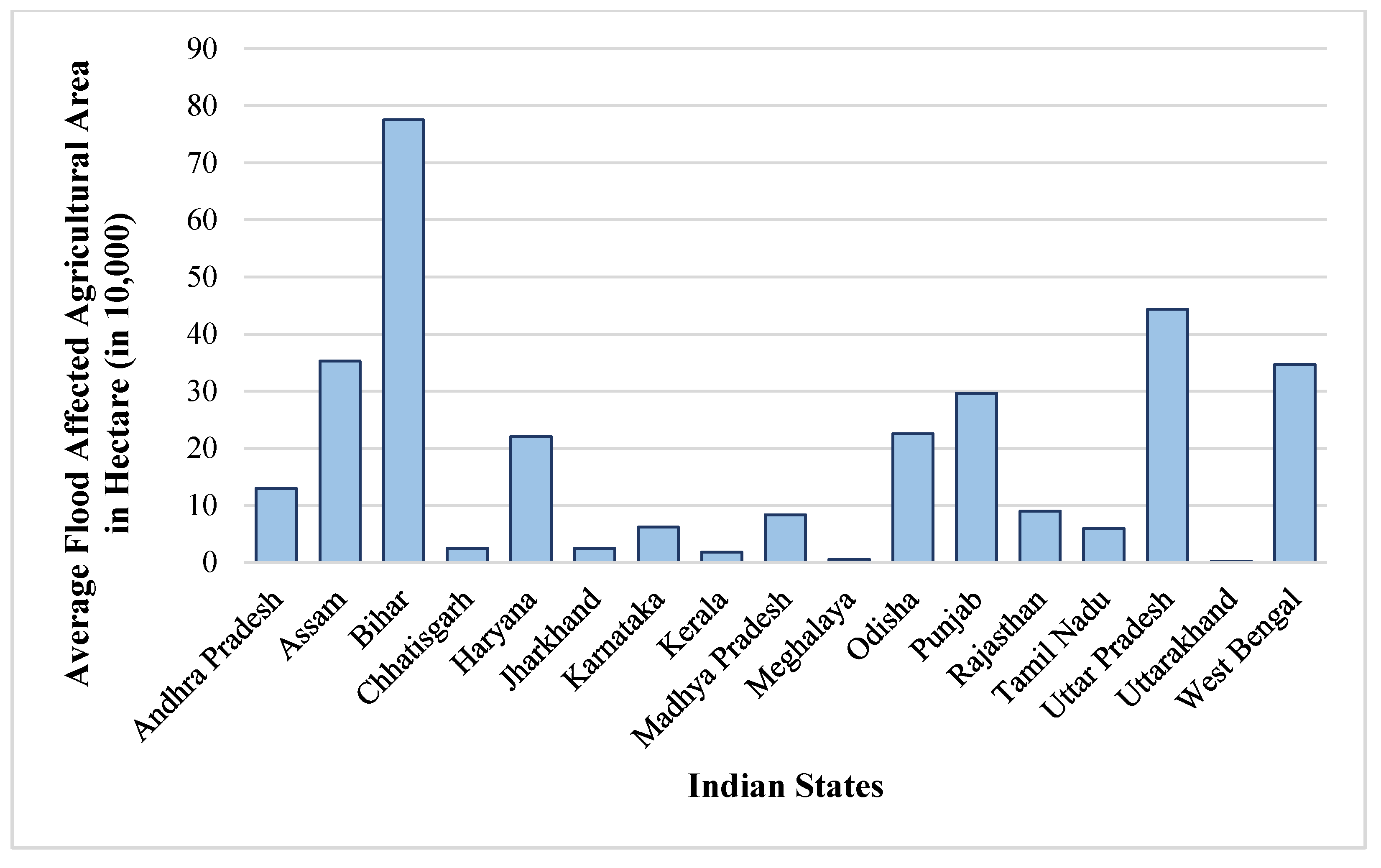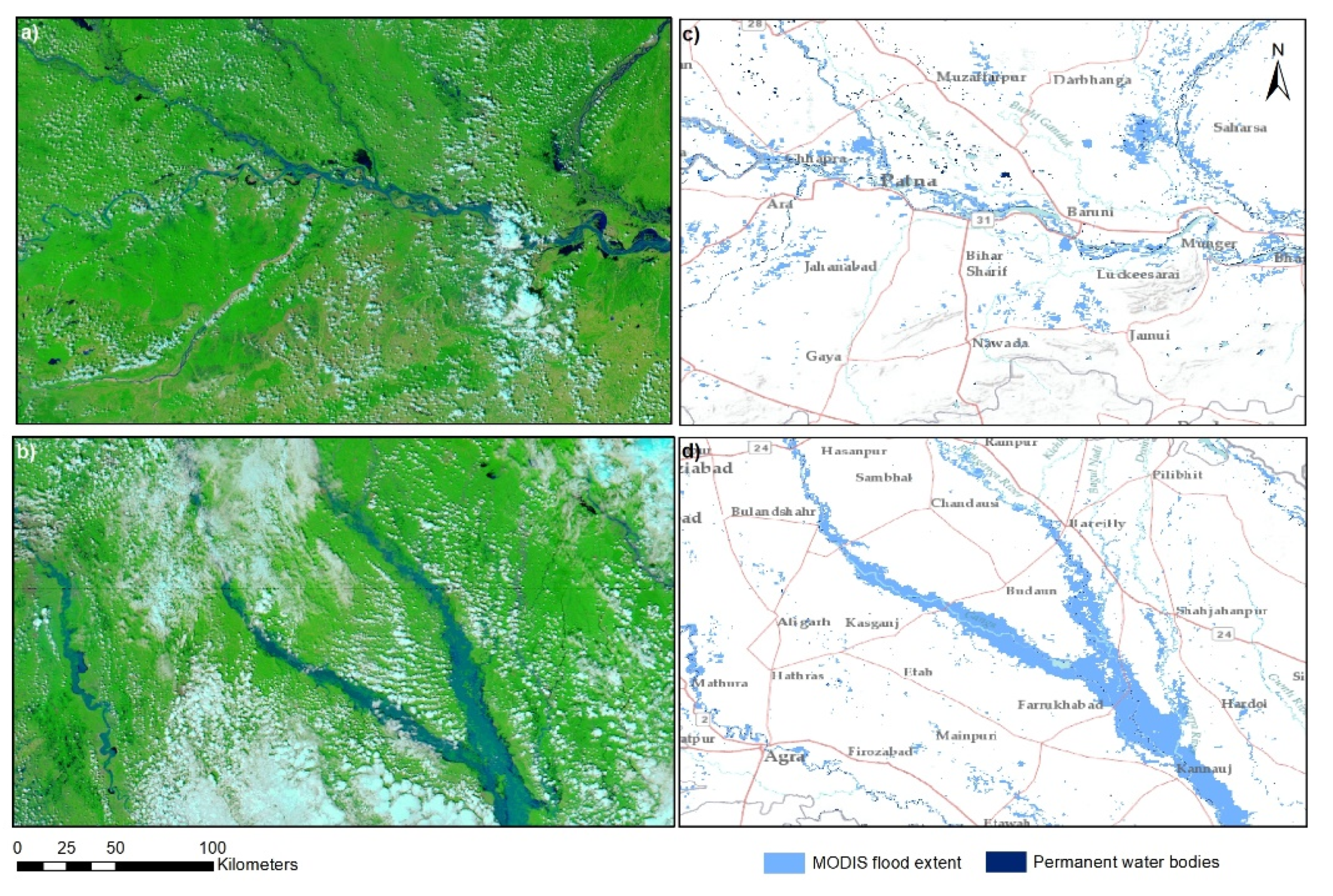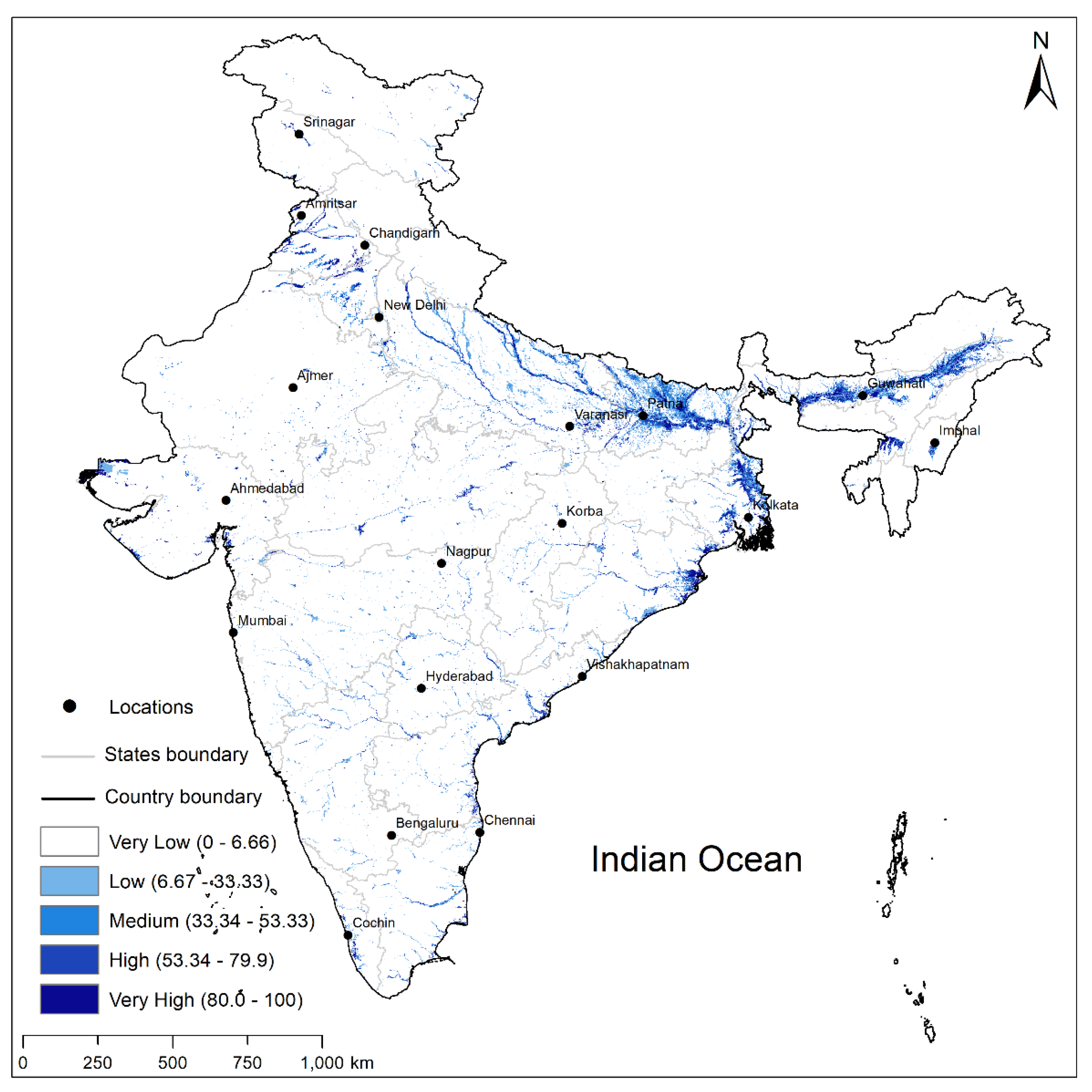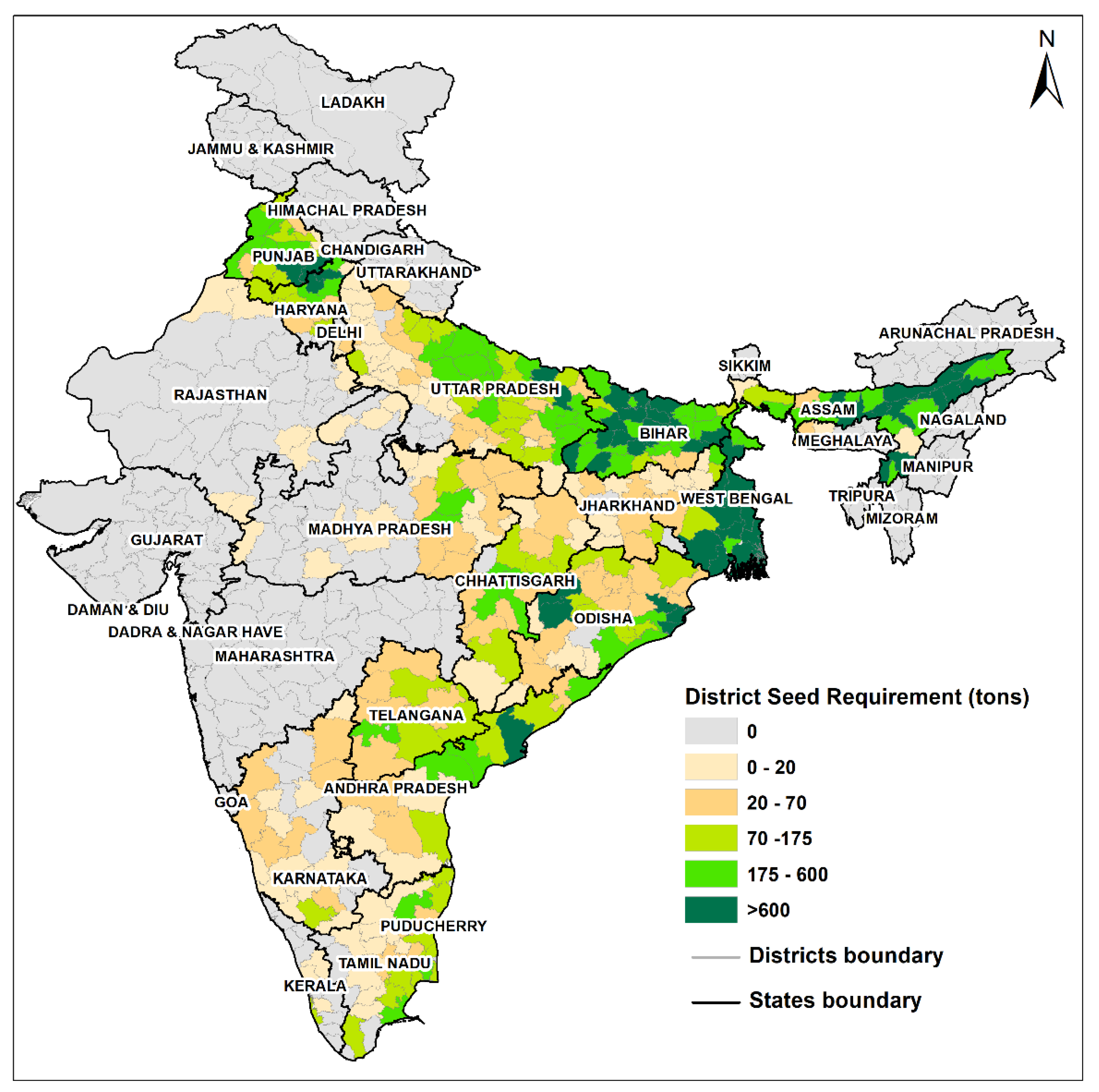Geospatial Assessment of Flood-Tolerant Rice Varieties to Guide Climate Adaptation Strategies in India
Abstract
:1. Introduction
1.1. Extent and Impact of Flooding on Rice Production
1.2. Flood-Tolerant Seed Variety: Swarna-Sub1
2. Data and Methodology
2.1. Mapping Flood Extent Using Satellite Data
2.2. Data for Estimating Seed Requirement
2.2.1. Land-Use Data
2.2.2. Data on Seed Rates
2.3. Estimation of Seed Requirement
3. Results
3.1. Flood Inundation Mapping
3.2. Seed Requirement Estimations
4. Discussion
5. Conclusions
Author Contributions
Funding
Institutional Review Board Statement
Informed Consent Statement
Data Availability Statement
Acknowledgments
Conflicts of Interest
References
- EM-DAT: The CRED/OFDA International Disaster Database. Available online: http://www.emdat.be/ (accessed on 12 June 2021).
- Amarnath, G.; Alahacoon, N.; Smakhtin, V.; Aggarwal, P. Mapping Multiple Climate-Related Hazards in South Asia. Colombo, Sri Lanka; IWMI Research Report 170; International Water Management Institute (IWMI): Gujarat, India, 2017; p. 41. [Google Scholar]
- IPCC. Summary for policymakers. In Climate Change: Impacts, Adaptation, and Vulnerability; Cambridge University Press: Cambridge, UK; New York, NY, USA, 2014; pp. 1–32. [Google Scholar]
- Central Water Commission. Hand Book for Flood Protection, Anti-Erosion and River Training Works; Flood Management Organization, Government of India: New Delhi, India, 2012. [Google Scholar]
- Amarasinghe, U.; Amarnath, G.; Alahacoon, N.; Ghosh, S. How Do Floods and Drought Impact Economic Growth and Human Development at the Sub-National Level in India? Climate 2020, 8, 123. [Google Scholar] [CrossRef]
- National Food Security Mission, Government of India. Available online: https://www.nfsm.gov.in/ (accessed on 10 January 2021).
- Dar, M.H.; Zaidi, N.W.; Waza, S.A.; Verulkar, S.B.; Ahmed, T.; Singh, P.K.; Iftekharuddaula, K.M. No yield penalty under favorable conditions paving the way for successful adoption of flood tolerant rice. Sci. Rep. 2018, 8, 9245. [Google Scholar] [CrossRef] [PubMed] [Green Version]
- Adkins, S.W.; Shiraishi, T.; McComb, J.A. Submergence tolerance of rice—A new glasshouse method for the experimental submergence of plants. Physiol. Plant. 1990, 80, 642–646. [Google Scholar] [CrossRef]
- Setter, T.L.; Ellis, M.; Laureles, E.V.; Ella, E.S.; Senadhira, D.; Mishra, S.B.; Sarkarung, S.; Datta, S. Physiology and genetics of submergence tolerance in rice. Ann. Bot. 1997, 79, 67–77. [Google Scholar] [CrossRef]
- Greenway, H.; Setter, T.L. Is There Anaerobic Metabolism in Submerged Rice Plants? A View Point; University of Agriculture and Technology and International Rice Research Institute: Manila, Philippines, 1996; pp. 11–30. [Google Scholar]
- Singh, R.K.; Reddy, J.N.; Singh, V.N.; Pani, D.R.; GHOSH, R.; Mackill, D.; Singh, U.S. Swarna-Sub 1-A boon for Submergence-Prone Rainfed Lowlands of Eastern India. In Proceedings of the 14th Australian Plant Breeding and 11th SABRAO Congress, Cairns, Australia, 10–14 August 2009; pp. 10–14. [Google Scholar]
- Nishiuchi, S.; Yamauchi, T.; Takahashi, H.; Kotula, L.; Nakazono, M. Mechanisms for coping with submergence and waterlogging in rice. Rice 2012, 5, 2. [Google Scholar] [CrossRef] [PubMed] [Green Version]
- Bhowmick, M.K.; Dhara, M.C.; Singh, S.; Dar, M.H.; Singh, U.S. Improved management options for submergence-tolerant (Sub1) rice genotype in flood-prone rainfed lowlands of West Bengal. Am. J. Plant Sci. 2014, 5, 14. [Google Scholar] [CrossRef] [Green Version]
- Portal for Disaster Compensation Disbursement, Government of India. Available online: http://aapda.bih.nic.in/(S(uymf3i2rsqqij0yapjfcb2kh))/Disaster2020/DisasterTypeDesc.aspx (accessed on 30 June 2021).
- Frenken, K. Irrigation in Southern and Eastern Asia in figures: AQUASTAT Survey-2011. Water Rep. 2012. Available online: http://www.rkmp.co.in/ (accessed on 13 January 2021).
- Dana, I.; Chatterjee, S. Swarna-Sub1: A Boon to the Farmers of West Bengal. STRASA News 2012, 5, 5. [Google Scholar]
- Ismail, A.M.; Singh, U.S.; Singh, S.; Dar, M.H.; Mackill, D.J. The contribution of submergence-tolerant (Sub1) rice varieties to food security in flood-prone rainfed lowland areas in Asia. Field Crops Res. 2013, 152, 83–93. [Google Scholar] [CrossRef]
- Dar, M.H.; Chakravorty, R.; Waza, S.A.; Sharma, M.; Zaidi, N.W.; Singh, A.N.; Singh, U.S.; Ismail, A.M. Transforming rice cultivation in flood prone coastal Odisha to ensure food and economic security. Food Secur. 2017, 9, 711–722. [Google Scholar] [CrossRef] [Green Version]
- Yamanot, T.; Malabayabas, M.; Gumma, M.K. Adoption, yield, and ex ante impact analysis of Swarna-Sub 1 in Eastern India. STRASA Econ. Briefs 2013, 2, 3–10. [Google Scholar]
- Mackill, D.J.; Ismail, A.M.; Singh, U.S.; Labios, R.V.; Paris, T.R. Development and rapid adoption of submergence-tolerant (Sub1) rice varieties. Adv. Agron. 2012, 115, 299–352. [Google Scholar]
- Dar, M.H.; De Janvry, A.; Emerick, K.; Raitzer, D.; Sadoulet, E. Flood-tolerant rice reduces yield variability and raises expected yield, differentially benefitting socially disadvantaged groups. Sci. Rep. 2013, 3, 3315. [Google Scholar] [CrossRef] [Green Version]
- Bailey-Serres, J.; Fukao, T.; Ronald, P.C.; Ismail, A.M.; Heuer, S.; Mackill, D. Submergence Tolerant Rice: SUB1′s Journey from Landrace to Modern Cultivar. Rice 2010, 3, 138–147. [Google Scholar] [CrossRef] [Green Version]
- Dash, S.R.; Routray, B.; Mohanty, S.K.; Behera, N. Evaluation of excess water tolerant rice varieties Swarna sub-1 and CR-1009 sub-1 under Head to Head Project in East and South- Eastern Coastal Plain zone of Odisha. Curr. Agric. Res. J. 2020, 8, 39–45. [Google Scholar] [CrossRef]
- Singh, U.S.; Dar, M.H.; Singh, S.; Zaidi, N.W.; Bari, M.A.; Mackill, D.J.; Collard, B.C.Y.; Singh, V.N.; Singh, J.P.; Reddy, J.N.; et al. Field performance, dissemination, impact and tracking of submergence tolerant (Sub1) rice varieties in South Asia. SABRAO J. Breed. Genet. 2013, 45, 112–131. [Google Scholar]
- Amarnath, G. An algorithm for rapid flood inundation mapping from optical data using a reflectance differencing technique. J. Flood Risk Manag. 2014, 7, 239–250. [Google Scholar] [CrossRef]
- Amarnath, G.; Rajah, A. An evaluation of flood inundation mapping from MODIS and ALOS satellites for Pakistan. Geomat. Nat. Hazards Risk 2016, 7, 1526–1537. [Google Scholar] [CrossRef] [Green Version]
- Amarnath, G.; Ameer, M.; Aggarwal, P.; Smakhtin, V. Detecting spatio-temporal changes in the extent of seasonal and annual flooding in South Asia using multi-resolution satellite data. In Proceedings of the International Society for Optics and Photonics (SPIE), Amsterdam, The Netherlands, 1–6 July 2012. [Google Scholar]
- Pandey, S.; Velasco, L. Economics of direct seeding in Asia: Patterns of adoption and research priorities. Int. Rice Res. Notes 1999, 24, 6–11. [Google Scholar]
- Tabbal, D.; Bouman, B.; Bhuiyan, S.; Sibayan, E.; Sattar, M. On-farm strategies for reducing water input in irrigated rice; case studies in the Philippines. Agric. Water Manag. 2002, 56, 93–112. [Google Scholar] [CrossRef]
- Pandey, S.; Mortimer, M.; Wade, L.; Tuong, T.P.; Lopez, K.; Hardy, B. Direct Seeding: Research Strategies and Opportunities; IRRI: Los Baños, Philippines, 2002. [Google Scholar]
- Singh, H.N.; Pandey, S.; Villano, R.A. Rainfed rice, risk, and technology adoption: Microeconomic evidence from eastern India. In Characterizing and Understanding Rainfed Environments; IRRI: Los Baños, Philippines, 2000; pp. 323–338. [Google Scholar]
- Trivedi, R.K.; Gunasekaran, M. Compendium on seed legislations. In Seeds Division, Department of Agriculture and Co-Operation; Ministry of Agriculture, Government of India: New Delhi, India, 2014; p. 148. [Google Scholar]
- Chauhan, J.S.; Prasad, S.R.; Pal, S.; Choudhury, P.R.; Bhaskar, K.U. Seed production of field crops in India: Quality assurance, status, impact and way forward. India J. Agric. Sci. 2016, 86, 563–579. [Google Scholar]
- Chauhan, J.S.; Satinder, P.; Prasad, S.R. Recent trends in breeder seed production of selected food and oilseed crops. In Proceedings of the 7th National Seed Congress, ‘Quality Seeds for Successful Agriculture’, Bhopal, Madhya Pradesh, India, 25–27 September 2014; pp. 103–105. [Google Scholar]
- Chauhan, J.S.; Prasad, S.R.; Pal, S.; Choudhury, P.R. Seed Systems and Supply Chain of Rice in India. J. Rice Res. 2017, 10, 9–15. [Google Scholar]
- IPCC. Climate Change 2014: Synthesis Report. In Contribution of Working Groups I, II and III to the Fifth Assessment Report of the Intergovernmental Panel on Climate Change; Core Writing Team, Pachauri, R.K., Meyer, L.A., Eds.; IPCC: Geneva, Switzerland, 2014; p. 151. [Google Scholar]






| Sr. No. | States | Seed Rate Using Direct Sowing Method | Seed Rate Using Transplantation | Weighted Average |
|---|---|---|---|---|
| 1 | Madhya Pradesh | 80 | 50 | 58.4 |
| 2 | Andhra Pradesh | 70 | 50 | 55.6 |
| 3 | West Bengal | 70 | 43.33 | 50.8 |
| 4 | Odisha | 80 | 30 | 44 |
| 5 | Bihar | 90 | 30 | 46.8 |
| 6 | Punjab | 17.5 | 25 | 22.9 |
| 7 | Uttar Pradesh | 75 | 21 | 36.12 |
| 8 | Karnataka | 80 | 62 | 67.04 |
| 9 | Kerala | 80 | 60 | 65.6 |
| 10 | Tamil Nadu | 80 | 43.33 | 53.59 |
| 11 | Haryana | 100 | 35 | 53.2 |
| 12 | Chhattisgarh | 80 | 30 | 44 |
| 13 | Jharkhand | 80 | 40 | 51.2 |
| 14 | Assam | 75 | 40 | 49.8 |
| 15 | Uttarakhand | 75 | 21 | 36.12 |
| 16 | Himachal | 80 | 30 | 44 |
| 17 | Rajasthan | 50 | 25 | 32 |
| State | Flood Affected Agricultural Area (ha) | Flood Affected Paddy Area (ha) | Seed Requirement (Tonnes) | Cost in Million INR | Cost in Millions USD | Ranking of States Based on Seed Requirement |
|---|---|---|---|---|---|---|
| Andhra Pradesh | 180,152.63 | 58,571.68 | 3256 | 130.24 | 1.86 | 8 |
| Assam | 484,214.47 | 305,204.90 | 15,200 | 608 | 8.69 | 3 |
| Bihar | 1,063,189.47 | 467,756.26 | 21,888 | 875.52 | 12.51 | 1 |
| Chhattisgarh | 31,644.74 | 26,402.19 | 1162 | 46.48 | 0.66 | 11 |
| Haryana | 183,084.21 | 65,467.11 | 3478 | 139.12 | 1.99 | 7 |
| Jharkhand | 28,696.05 | 21,289.74 | 1092 | 43.68 | 0.62 | 12 |
| Kerala | 19,019.74 | 1796.07 | 116 | 4.64 | 0.07 | 14 |
| Madhya Pradesh | 91,780.26 | 20,983.37 | 1224 | 48.96 | 0.70 | 10 |
| Meghalaya | 6477.63 | 1449.99 | 70 | 2.80 | 0.04 | 15 |
| Odisha | 291,390.79 | 248,963.81 | 10,958 | 438.32 | 6.26 | 4 |
| Punjab | 298,363.16 | 211,419.15 | 4844 | 193.76 | 2.77 | 6 |
| Rajasthan | 68,869.74 | 885.49 | 28 | 1.12 | 0.02 | 16 |
| Tamil Nadu | 85,164.47 | 37,249.61 | 1996 | 79.84 | 1.14 | 9 |
| Uttar Pradesh | 486,614.30 | 227,700.22 | 8216 | 328.64 | 4.69 | 5 |
| Uttarakhand | 2217.11 | 605.42 | 22 | 0.88 | 0.01 | 17 |
| West Bengal | 542,385.73 | 367,816.48 | 18,684 | 747.36 | 10.68 | 2 |
| Karnataka | 76,267.11 | 7914.67 | 530 | 21.20 | 0.30 | 13 |
| Total | 3,939,531.60 | 2,071,476.16 | 92,764 | 3,710.56 | 53.01 |
Publisher’s Note: MDPI stays neutral with regard to jurisdictional claims in published maps and institutional affiliations. |
© 2021 by the authors. Licensee MDPI, Basel, Switzerland. This article is an open access article distributed under the terms and conditions of the Creative Commons Attribution (CC BY) license (https://creativecommons.org/licenses/by/4.0/).
Share and Cite
Koppa, N.; Amarnath, G. Geospatial Assessment of Flood-Tolerant Rice Varieties to Guide Climate Adaptation Strategies in India. Climate 2021, 9, 151. https://0-doi-org.brum.beds.ac.uk/10.3390/cli9100151
Koppa N, Amarnath G. Geospatial Assessment of Flood-Tolerant Rice Varieties to Guide Climate Adaptation Strategies in India. Climate. 2021; 9(10):151. https://0-doi-org.brum.beds.ac.uk/10.3390/cli9100151
Chicago/Turabian StyleKoppa, Nisha, and Giriraj Amarnath. 2021. "Geospatial Assessment of Flood-Tolerant Rice Varieties to Guide Climate Adaptation Strategies in India" Climate 9, no. 10: 151. https://0-doi-org.brum.beds.ac.uk/10.3390/cli9100151





